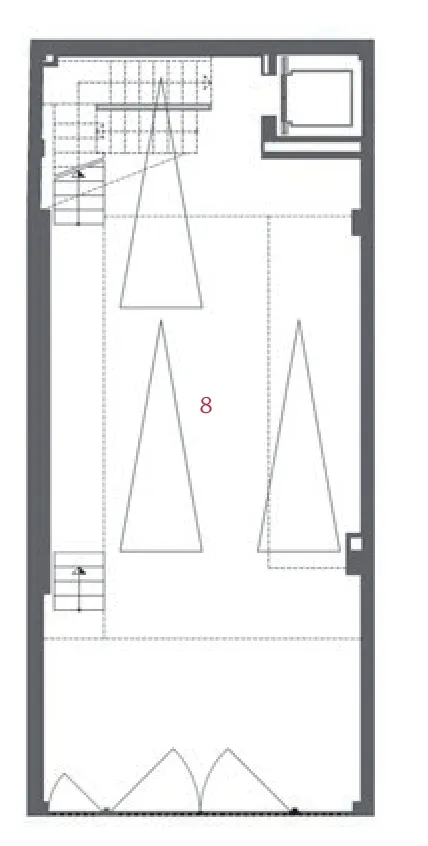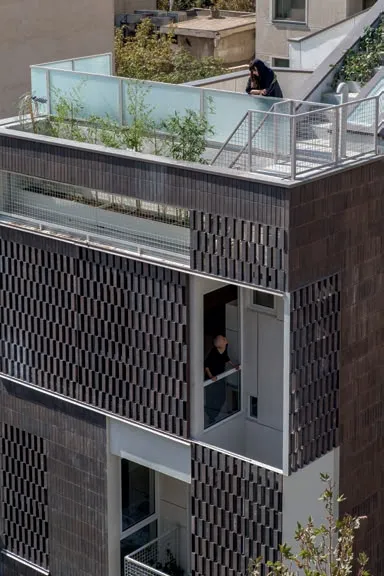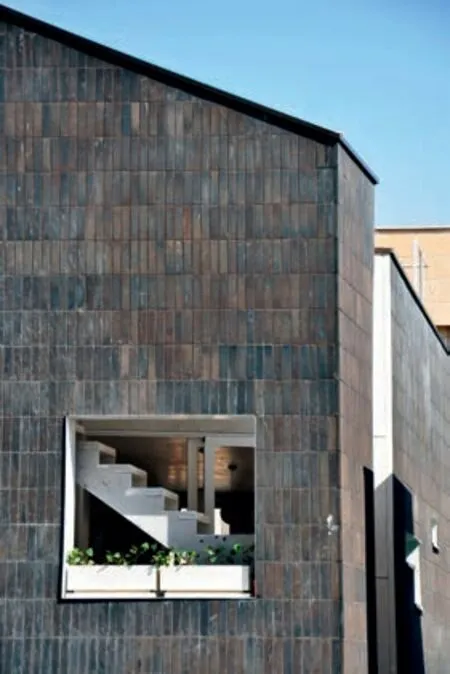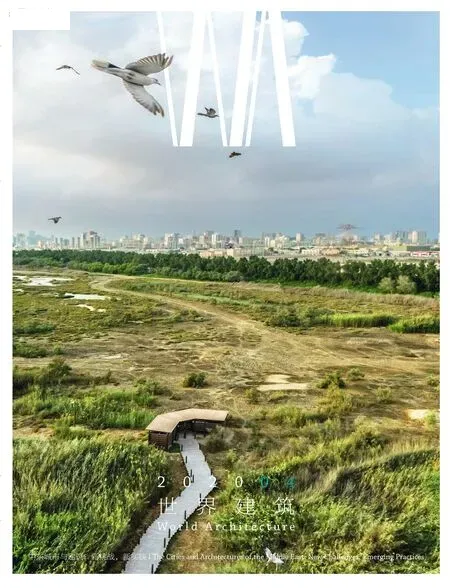埃尔克哈尼住宅楼,德黑兰,伊朗
建筑设计:[Shift] Process Practice建筑事务所
伊朗人在20 世纪经历了迅速的现代化历程。首都德黑兰进行了大规模重建,原来两层楼的建筑被4~5 层的公寓楼替代,城市的生活方式也随之改变。在这个过程中,一些住宅的理念与建造传统逐渐被淘汰,比如住房与花园的连接,住宅空间的公共部分,以及由精心设计的剖面与平面上的连接带来的室内空间的内在复杂性。在埃尔克哈尼住宅楼项目中,我们希望重新认识伊朗的住宅空间所遗失的价值。
埃尔克哈尼是一栋4 层楼的建筑,内有供一个大家庭居住的3 套住宅。项目基地的北侧是一个封闭的内部地块,与街道的唯一联系是本项目基地西面的一条1m 宽的小巷。而项目基地东侧的地块,其深度是本项目基地与北侧地块的深度之和。这意味着东侧地块的建筑的体量永远不会遮盖我们项目的东立面。因此,我们的建筑有4 个独立的立面,而根据区域规划,这座建筑竟只算作填充物。在埃尔克哈尼住宅楼的设计中,我们试图探索这个独特的类型——具有4 个立面的填充建筑的潜力。建筑的外墙材料采用本地生产的砖。在南立面,局部外挑或退后的屋顶结构板产生了一系列袋形空间,这些空间体量的组合创造了一系列相连的阳台。建筑南侧的大部分室内空间都从侧面与阳台相接,而非直接向街道敞开。这些相连的阳台可看作绿色的口袋花园。在南立面还部分采用了半镂空的多孔砖墙,作为建筑的第二层表皮。这层遮阳砖帘是部分可移动的,住户可根据自身需求移动砖帘来获得室外景色和采光,同时也让立面构成产生变化。
在剖面构成上,项目充分利用了夹在中间的袋形空间和垂直墙面来创造居住空间。为了把建筑的垂直墙面纳入住户的日常生活中,我们在建筑西侧设计了内表面可与常用家电和家具结合的墙体。
位于建筑北侧的楼梯间是住宅与北边相邻地块之间的缓冲区,楼梯间北面和西面的间接光照为这里带来了充足的自然光线。因此,与许多其他公寓楼有所不同的是,楼梯间是埃尔克哈尼住宅楼的社交中心,居民在此相遇,互相问候。从建筑北侧的室内也可以看到这个社交空间。□(母卓尔 译)

1 鸟瞰/Aerial view

2 图示:可动砖屏设计使南立面形成的动态变化/Diagrams:the dynamic transformation of southern façade due to the design of operable brick shades.

3 鸟瞰/Aerial view
During the twentieth century, Iranians were rapidly modernised.The capital city of Tehran was rebuilt substantially.The two-story homes were substituted with four to five-story apartment buildings and urban lifestyle was modified accordingly.Certain traditions in the conception and erection of domestic space were rendered obsolete in this process, including the connection of the house with the garden, the communal aspects of domestic spaces, and the intrinsic spatial sophistication of interiors that was the product of well-crafted sectional and planar connections.Eilkhaneh is our attempt to re-evaluate the lost values of Iranian domestic space.
Eilkhaneh is a four-story building that houses three residential units for members of one big family.The lot of the project meets an inner lot in the north that has street access limited to a onemeter-wide alley along the western border of our project.In the east, the neighbouring lot has a depth that is equal to the sum of the depth of our project's lot plus that of the northern neighbour.This means that the mass of the building in the eastern lot will never cover the eastern façade of our project.Hence, our project ends up having four façades, whereas according to the zoning by-laws it is considered an infill! In designing Eilkhaneh,we have tried to explore the potentials of such a unique typology: an infill with four façades.For the exterior façades, we chose locally produced bricks.In the southern façade, the volumetric composition of a series of spatial pockets that are the result of localised extrusions and intrusions of the structural roof plates has created a series of connected balconies.Most of the interior spaces located at the southern part of the building look into these balconies laterally, as opposed to opening up to the street.These connected balconies are envisioned as little green pockets.In parts of the southern façade,a semi-transparent and porous brick wall functions as a second skin.The brick shades are partially operable, allowing for the transformation of the façade composition in terms of access to a view and natural light, according to the desires of the occupants.
The sectional composition of the project allows in-between spatial pockets and vertical surfaces to become partially habitable.To include the vertical architectural surfaces in the programming of the daily life of the inhabitants, the western interior surface is designed to house ordinary appliances and domestic furniture.
The staircase located in the northern part of the building functions as a buffer zone between the residential units and the northern neighbours and enjoys ample natural light due to indirect access from the northern and western sides.Hence,unlike many apartment buildings, in Eilkhaneh the staircase is the social nucleus of the building where residents meet and greet one another.The interior spaces located in the northern part look into this social space as well.□

4 地下平面/Basement plan

5 首层平面/Ground floor plan

6 二层平面/First floor plan

7 三层平面/Second floor plan

8 四层平面/Third floor plan
项目信息/Credits and Data
客户/Client: Abol-Ghassem Nabian
地点/Location: Zaferaniyeh District, Tehran, Iran
施工方/Construction: Abol-Ghassem Nabian
主持建筑师/Principal Architects: Rambod Eilkhani, Nashid Nabian, Dorna Mesrzadeh
设计团队/Design Team: Parnian Ghaemi, Diba Dayani,Golnaz Jamshidi, Mohsen Khanmohammadi, Milica Milosevic, Mehrasa Chamani Heydari
合作者/Collaborators: Hesamodin Raoufpanah(结构/Structural), Alireza Ansari Amin(施工/Construction)
结构设计/Structural Design: Morteza Rezaii Mehr
顾问/Consultants: Ali Ghanizadeh and Ali Piltan (MEP)
材料/Materials: 结构:钢材;地面:天然木材,玻璃
条垫片浇筑马赛克;外立面:当地产砖块,钢骨架/Structure: steel; Floorings: natural wood, poured mosaic with glass bar spacers; Exterior façades: locally produced brick with steel frame
占地面积/Plot Area: 102.5m2
建筑面积/Floor Area: 481.16m2
造价/Cost: 20,300,000,000 IRR (437,000 USD)
设计时间/Design Time: 2012.06-2012.12
施工时间/Construction Time: 2013.01-2014.09
竣工时间/Completion Time: 2014.09
绘图/Drawings: [SHIFT] Process Practice
摄影/Photos: Parham Taghioff (fig.1,11,12,17-21), [SHIFT]Process Practice (fig.3,22)

10 屋顶平面/Roof plan

11 夜景/Night view

12 鸟瞰/Aerial view

13 图示:对于窄巷中邻里间视线和自然光如何协调的研究/Diagram: a lesson on how to negotiate view and natural light in narrow alleys between neighbours

14相邻楼间的普遍做法/What is normally done in an Inner Lot situation

15本项目对于相邻楼间的处理办法/What we have done for the neighbouring Inner Lot

16剖面/Section

17.18 内景/Interior views

19 从阳台向上看/Looking up from the balcony

20 阳台实景/View of the balcony
评论
青锋:在一个狭小的地段中,设计者充分利用了高度的变化,错动的楼板带来了很多难以在平面上直接阅读出来的空间变化。可移动的花砖遮阳别出心裁,可以带来光线与节奏的变化。这些丰富的细节似乎对应于家庭生活的多元色彩,这也可能是当年阿道夫·卢斯要在住宅中探索“空间规划”的原因。这种在狭窄地段中的操作技巧,对于高密度的亚洲城市来说是非常有效的手段。尤其是对邻居的照顾,展现了一种令人赞赏的温和。令人有些意外的是外墙材料的选择,看起来有些过于强硬,或许更多的植物可以改变这种印象。
卡拉·阿拉莫尼:由[Shift] Process Practice设计的这个住宅项目优美地坐落于社区中,设计充分发掘了光线、视觉连接,以及室内社交空间的潜能。通过巧妙运用不同楼层的截面,设计为每一个住宅单元提供了独特的布局和空间感受。建筑师巧妙地将楼梯与建筑的北侧外立面相结合,形成了一个社交空间和光井。通过使用当地暗色调的砖块作为充满变化的建筑表层,建筑体在各种镂空的开放设计和侧面视觉连接之间获得了一种和谐统一的质感。(钱芳 译)

21 屋顶花园/Roof garden

22 立面近景/Close-up of façade
Comments
QING Feng: The designer makes full use of floor height changes on a small lot.The crisscrossed floors create myriad spatial changes that are hard to read directly from the plan.The operable brick shades are quite unique, allowing for changes in light and rhythm.These rich details seem to correspond to the richness of family life, which might also be the reason why Adolf Loos explored the concept of "Raumplan" in the design of houses.Such design skills on narrow lots are very effective for high-density Asian cities.Particularly, the concern for adjacent neighbourhoods admirably shows gentleness.The material of the exterior façades is somewhat surprising and looks a bit tough.Planting more plants might help change this impression.(Translated by MU Zhuo'er)
Carla Aramouny: The housing project by [Shift] Process Practice beautifully sits in its neighbourhood, as its design negotiates potentials of light, visual links, and internal social spaces.The design employs a sectional play of levels to give each of the individual housing units its unique layout and spatial experience.The northern façade,instead of being left as a blank façade, is designed instead to cleverly integrate a connective stairway that operates as a social space and light well.The architects' elegant use of dark-toned local brick as a shifting skin gives the housing block a harmonised quality with various moments of perforated openness and lateral visual connections.

